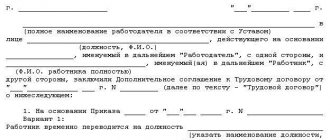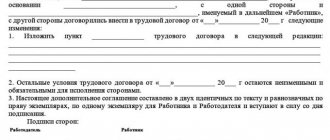Dismissal is a procedure for breaking the labor relationship between a subordinate and the head of an institution, which can be confirmed by a resignation letter confirming the subordinate’s intention to leave the enterprise. The procedure for executing the deduction procedure when transferring a specialist to a new company in 2020 is reflected in the Labor Code (LC) of the Russian Federation.
Transfer to a new institution is an action involving the preparation of an application for payment with the prospect of getting a job in a new company. Having studied the features of the legislation, you can get away from various problems, with a clear understanding of the actions, both for the boss and the subordinate.
Article
Content:
The law provides for the possibility of changing an institution according to the stipulated standards for terminating an employment agreement on the basis of Article 77 of the Labor Code of the Russian Federation. Calculated payments to an employee and the preparation of the necessary certificates are carried out according to the general standards reflected in Article 80 of the Labor Code of the Russian Federation. The only difference is the filling out of the work book, in which a record is filled out that the specialist was expelled in the order of transfer.
The resignation of a specialist by way of transfer is regulated by Article 72.1 of the Labor Code of the Russian Federation, which provides for 2 methods of such transfer:
- External transfer, representing a change by an employee of an institution, with departure from the previous one (clause 5, part 1, article 77 of the Labor Code).
- Internal transfer is a change of position or department in the same institution without deduction, with the consent of the subordinate (part 2 and part 3 of article 72.2 of the Labor Code).
Transferring a specialist to another institution requires that the person being dismissed negotiates with the current and future management about all the nuances of the transition. Moreover, such a transfer can be carried out either at the request of the subordinate or at the initiative of the superiors.
Practice notes that translation is most often performed on the basis of a written invitation from the head of the future institution. The invitation must display the date from which the future management is ready to employ the specialist at the new company. As an addition, the notification may display the salary with which the subordinate will work and attach a mock-up of the employment contract.
Having received an invitation, the current manager is obliged to obtain the consent of a colleague to move to a new company. If a subordinate confirms his desire to resign by way of transfer, he is required to submit a petition for this (Article 72.1 of the Labor Code of the Russian Federation). An invitation from the head of the future institution must be attached to the petition. Based on the documents presented, the current manager is obliged to send written confirmation to the receiving institution, after which an order of expulsion is issued. This situation is more like a dismissal procedure by agreement of the parties.
All documents upon dismissal are drawn up on unified forms shown in Resolution of the State Statistics Committee No. 1 of 01/05/2004. Registration of work books is carried out in accordance with the resolution of the Ministry of Labor No. 69 of October 10, 2003.
If a labor conflict arises, the employee is given the right to appeal to judicial structures within 3 months from the date of awareness of the rights violated in relation to him in accordance with Art. 392 Labor Code of the Russian Federation.
In case of conflicts regarding expulsion, a citizen can file a claim with the courts within one month from the date of receiving a copy of the order on expulsion or from the date of receipt of the work record book.
Procedure and procedure for the employer
For any type of transition from one position to another, the following mandatory documents are required:
- a completed application form from the resigning employee;
- a written invitation from a new employer;
- an agreement drawn up in the form of a letter concluded between two managers. This document is drawn up if the decision was made by the current employer.
All documents indicate the full name of the new company, vacancy, job responsibilities, department or division, salary, work and rest hours.
What to do if an employee does not agree with the place provided? In this case, the employer can dismiss the employee without transfer. If the worker agrees to move to another position, this is communicated in writing. For the HR department, the dismissal procedure does not change and occurs in the same way as with the usual departure of an employee.
There are minor transition nuances for external and internal types.
The transfer of an employee through dismissal in one organization requires written approval of this process. The HR department is preparing an order to complete the procedure. The document is signed and comes into force.
We recommend you study! Follow the link:
Does the Labor Code allow the dismissal of a pregnant woman?
An internal transfer is properly executed if an additional agreement is concluded with the employee. The document specifies the terms of the transition, the amount of wages, and the future position.
The head of the enterprise from which the transfer employee plans to leave must have sufficient grounds for dismissal. If an invitation has been received from a new company and the current employer agrees, then it is legal to use the translation article.
Example of an invitation letter:
If the employer refuses to let the employee go, the latter must write a statement of his own free will and indicate the appropriate article.
It is important to understand that when a citizen leaves the company due to transfer to a new position, the new management is obliged to accept the employee. Otherwise, the latter has every right to apply to the judicial authorities to protect his right to employment.
At the same time, the worker is not released from the obligation to work 14 days at the old place of work after submitting the application.
Today the law has become strict in relation to deadlines in documents. In particular, this applies to a letter of invitation, dismissal from and the conclusion of a new employment contract. Previously, the labor code stated that a new employer cannot refuse an employee to draw up an employment agreement, even if he appears after three months. It was Article 16, these conditions were prescribed in paragraph 2.
Later changes were made. In 2020, upon receiving a letter inviting a new position, the employee is obliged to come to another enterprise within 30 days from the date specified in the document. If this does not happen, then the further conclusion of the employment contract remains at the discretion of the new employer.
Unilateral cancellation of an invitation is not possible. Otherwise, the new applicant applies to the judicial authorities and restores his rights.
Rules for registering dismissal by transfer
The standards of the Labor Code of the Russian Federation assume that if a specialist moves to a new company by transfer, the employment contract with him is terminated.
That is, a person quits on his own initiative. This option of resignation involves a break in the labor relationship due to the transfer of a subordinate to a new institution, that is, the working conditions, earnings and daily routine may change here. All these nuances must be discussed with the subordinate the day before the transfer and an agreement for the transfer must be drawn up in writing. The legal side of such an event is regulated by clause 5 of Art. 77 of the Labor Code of the Russian Federation, which regulates the circumstances of termination of an employment contract. It turns out that the reason for breaking the labor relationship of the parties is a change of specialist in the institution. Transfer, in this case, is allowed only with the consent of the subordinate or at his suggestion, that is, for the transfer of a specialist, it is necessary that he submit a written request for this.
Before transferring a subordinate to a new institution, the current manager is required to draw up a written agreement the day before with the future institution hosting the specialist. Without such a document or a request from the receiving institution for a specialist, the transfer cannot be considered legally valid. Therefore, the manager needs to familiarize himself with:
- What vacancy is the specialist being nominated for?
- The amount of his earnings.
- Requirements for qualification level and education.
- Layout of the employment contract, which the specialist needs to familiarize himself with.
Typically, such information is displayed in a written invitation from a specialist, which is sent from the receiving party to the management of the current enterprise.
This prompt should display:
- Obligations of the parties.
- Translation deadlines.
- Position, salary, working conditions, where the specialist is transferred.
- Algorithm of the translation process.
After transferring the listed materials to the personnel officer and familiarizing himself with the future work during the transfer, a written agreement is concluded between the management and the subordinate to move to the new institution. The specialist’s signature in the agreement indicates his permission to transfer. At the same time, he has the right to refuse this offer. When the transfer is authorized, the subordinate submits a request for deduction in connection with the transfer to a new company.
For a specialist, a transfer is considered a more advantageous offer than an ordinary resignation by agreement of the parties, on personal initiative or due to staff reduction, since there is no need to look for a job, there is no break in experience, and earnings at a new company may be even greater than at the current one. Qualified workers can be assessed at a high level by the company that requested it. Therefore, in such circumstances, a specialist usually immediately agrees not to transfer to a new company, especially since a probationary period is not assigned during the transfer.
An example of an invitation from a company hosting a specialist.
Translation of maternity leave
When an enterprise has employees who are on maternity leave, then any actions in relation to them are of a special nature and have nuances.
Dismissal and transfer to a new job takes place only with the consent of the citizen. Article 72.1 of the labor law does not clarify the issue of pregnant women and child care. The process is accompanied by exemption from official duties at the old enterprise and official registration at the new one.
Article 84.1 regulates the documents provided and the procedure:
- an application form is filled out requesting dismissal due to transfer;
- an order for the enterprise is being prepared. The basis is a statement;
- the employee reads this document and signs;
- a work permit is issued.
There is no single application form, so the paper is filled out randomly, but with the required details indicated:
- personal data of the employee, position held;
- the date, month and year for which the transfer is scheduled is indicated;
- write the full name of the new company and what position you plan to occupy.
Starting a new job must occur within 30 days. If the deadline is missed, the new employer may refuse to hire the employee for the vacancy. This is regulated in Article 64 of the Labor Code.
An employer, having a young mother or expectant mother on staff, must know the specifics of dismissal:
- The release of the workplace occurs only at the request of the maternity leaver. The employer does not have the right to carry out this procedure at his own discretion. The labor contract states Article 77, paragraph 5 in the first part;
- An early call from maternity leave if the baby is under three years old is impossible. Even if it is necessary for paperwork. They discuss with the woman a date when it will be convenient for her to come to the HR department or make an appointment at home;
- before starting the dismissal procedure, the maternity leaver must give written consent;
- If a woman is on maternity leave, the leave is interrupted at her old place of work and resumed at a new one, after submitting the appropriate application.
To ensure that the transfer does not violate Article 72.1, which stipulates the prohibition of providing a workplace that is contraindicated for medical reasons, it is necessary to make sure that the employee can work in the new position and this will not threaten her health.
Otherwise, the procedure and documents correspond to the standard dismissal for the transfer of an ordinary employee.
How to write a letter of resignation by transfer
The regulations do not develop a standard form for a request for resignation in the order of transfer.
At the same time, the company’s management has the right to approve a template for such a form for departmental use in the company’s office work. The application must be submitted in writing by hand or printed on a printer when using a computer. The document can be drawn up on a blank standard A4 sheet or on the institution’s letterhead.
- The following information is displayed in the header of the letter (filled out in the right, upper part of the sheet):
- Position of the manager, name of the institution, indicating the legal status where the specialist works and full name. boss
- Information about the applicant (position, structural department, rank, full name).
- Below in the center of the line the phrase “Statement” is written.
- In the main section of the form, fill out a text that outlines the essence of the specialist’s request. Here you need to clearly state all the wording. An example of such a text could be the following: “I request that you release me from my position on September 21, 2019 in order to transfer me to TEMP LLC in accordance with clause 5, part 1, article 77 of the Labor Code of the Russian Federation.”
An invitation from the receiving party must be attached to the form. In this option, below the main part of the application, the phrase “Attachment” is written on the left, displaying the name of the attached invitation.
Finally, the form is signed by the applicant with a transcript of the signature, and the date of registration of the application is recorded.
The application form is registered in the HR department, with further forwarding to the boss for approval. To avoid any misunderstandings, it is advisable to submit the request in 2 copies, so that the submitter’s copy contains a mark indicating the registration of the submitted petition indicating the date of registration. Such insurance is needed in case the application is lost among other letters.
Notice from the new employer.
You can contact your employer with an application only if you have in your hands a notification of an invitation to work from a potential employer.
It is important that this document is drawn up correctly and contains all the necessary information:
- Organization name or full name. individual entrepreneur, address of place of registration, TIN, registration number;
- FULL NAME. invited employee;
- The position to which the employee is invited;
- Position and full name the person who signed the notice;
- Date of document creation.
Is it possible to withdraw an application?
Article 80 of the Labor Code of the Russian Federation states that an employee can terminate the relationship with the employer by notifying him in writing 2 weeks in advance.
The same law provides for the right of a worker who has submitted a resignation letter to have it cancelled. A specialist who has expressed his intention to move to another company has the right to change his mind about leaving, but only up to a certain point:
- After the specialist has signed a special agreement, the applicant cannot withdraw the application. The only option for canceling the transition procedure is a mutual agreement to cancel the additional agreement.
- If the employment contract with the new management has already been signed, then withdrawal of the application is not allowed.
https://youtu.be/CZuMNl-kqO0
Does an employee have to justify their desire to transfer?
Some employers require resigning employees to indicate in the application the reason for the transfer: an offer of a higher salary, convenient working conditions, etc. Such a requirement is illegal, because it is enough for employees to indicate the wording “I ask you to fire me in connection with the transfer to LLC “N””, without explaining the motives for their actions.
If the termination of the employment contract is carried out at the invitation of another manager, you can indicate confirmation of your intentions in the application.
When the transfer is carried out within the organization, the director is obliged to justify his decision to transfer the subordinate to another position. The dismissal order must contain information about who initiated the procedure.
As a rule, personal initiative from an employee comes in situations where he has already found a potential new employer and has managed to discuss with him all the details regarding subsequent employment.
If the employer is willing to hire an employee, in order to initiate the transfer process, he will need to make a written request to the current employer, indicating confirmation that he will provide a place for the employee. Notice will be given by mail or other means.
Detailed instructions when moving to a new place of employment at the employee’s request will be as follows:
- A letter is sent to the current management from a structure that is ready to accept a citizen into service. There are no requirements for the text of the letter, however, the sample must be drawn up on company letterhead, and a time frame must be defined in it.
- The employee writes a statement addressed to the manager, in which he indicates that he wishes to transfer to work in another organization, indicating its name and position.
- After signing the application for dismissal by transfer, a confirmation letter about the transfer is sent to the second organization.
- The manager forms a dismissal order, in which he indicates that the procedure was carried out at the initiative of the employee, and makes a reference to clause 5, part 1, article 77 of the Labor Code of the Russian Federation.
- The order is recorded in the registration journal, and must be familiarized with it in writing to the employee who is required to sign it.
- A record of dismissal is placed in the employee’s personal card, and a link is placed to the current norms of labor legislation, namely Article 77 of the Labor Code of the Russian Federation. Once the employee has reviewed all the records, his signature on the card will be required.
- An entry is made in the work book in accordance with the requirements of the Instructions, and on the same day the final settlement with the employee is made, including wages, additional payments and bonuses, compensation for vacation, etc.
- The employee is given all the documentation, including a work book and a certificate of income, after which he must begin a new service within 30 days. All documents that will be prepared by the new employer will indicate that the hiring was carried out by transfer.
In case of transfer, the current employer is obliged to pay the employee in full. If this is not done, the transfer process will be delayed, and conflict situations that arise will have to be resolved in court.
It is established by law that when transferring to a new organization, the current manager is obliged to make the following payments in favor of his employee:
- earnings for the time actually worked, as well as wage arrears, if any at the time of transfer;
- compensation for unused vacation days;
- various bonuses and additional payments for overtime, performance of official duties outside working hours and at night.
Transfer to another organization can be carried out at the initiative of both the employee and the employer. The main condition is the written consent of the personnel to this action. External transfer differs from other types of transfers in that labor relations with the management of the first organization are severed, and with the management of the second they arise.
Another organization can be absolutely any form of employer: an individual or legal entity, public or private enterprise. These organizations may have one or different founders, one or different departments. This does not make any difference to the translation procedure. It must be remembered that branches and other divisions of an enterprise are not another organization, therefore a transfer from one branch to another is not a transfer to another organization.
The initiator of a transfer to another company can be both the employee and his employer. But in both situations it is necessary to terminate one employment contract and enter into a new one in return. In this case, no additional agreement is allowed. This is explained by the fact that this procedure involves not two persons, but three: the employee, the current and potential employers.
So, in order to make a transfer, the written consent of the following participants is required:
- employee;
- the employer for whom he currently works;
- an employer who wants to employ this personnel.
Translation stages:
- The first step before translation is correspondence. It passes between the organization in which the person works and the company that wants to host this employee. The second enterprise asks the first to transfer the person to them. At this stage, the most important document is the invitation letter, which contains a request for transfer. This document shows that the inviting party agrees to host the employee.
- At the second stage, it is necessary to obtain the consent of the frame itself. The main factor here is who initiated the transfer - the employer or the employee. If the employer, then it is imperative that the employee writes a written agreement. Consent can be expressed in the following forms:
- The inscription on the employer’s offer of transfer: “I agree to the transfer”;
Separately written agreement.
Also, as consent, a resignation letter may be considered, the reason for which is a transfer to another organization. An invitation letter from the new company can be attached to this application. Consent is also considered a general agreement between the employer and employee on the transfer, which is confirmed by the termination of the employment contract.
The employee must receive monetary compensation in the form of salary for the time he worked, as well as for unused vacations. They pay him on the day of actual dismissal. If for some reason a person was unable to receive the money within the period established by law, then he can come for payment no later than the next day after declaring his desire to receive the necessary compensation.
If dismissal by transfer occurs at the time of illness, then the management of the organization must pay the person the entire amount due to him as sick leave. If an enterprise has no money, this is not a reason for non-payment of financial compensation.
- If the initiator of the transfer is an employee, then a written statement about this is required from him. In order to have some guarantees, he may require a letter of invitation from the potential employer. This will give him the opportunity to conclude a new employment contract within a month, and he can also count on paying for his move to an organization located in another area. The employee’s desire must be reported to the management of the company where he wants to get a job. The work record book will indicate that the transfer was made at the request of the employee. The new company does not have the right to refuse to conclude an employment contract with the transferred person. If this condition is violated, a fine will be imposed. It is also impossible to set a probationary period for the transferred person. In this version of the transfer, the current management may require the personnel to work for the period established by law, which cannot exceed two weeks. This is necessary so that management has the opportunity to find an appropriate specialist for the vacant position.
- A contract between two organizations may be the reason for the transfer. This happens when one enterprise is going to close, and in order to provide its employees with new jobs, it negotiates with other companies to provide vacancies. Such a transfer requires an agreement of three parties. First of all, the head of the company where the person who is to be transferred works sends a letter of request to another company with a request to hire a new specialist. In one letter you can request a transfer for one or several people. After receiving and reading this letter, the management of the new company writes its resolution. If consent is received, then the previous management draws up a dismissal order.
We invite you to familiarize yourself with: The procedure for dismissal due to staff reduction in 2020
Order of dismissal by transfer
The transfer deduction process is carried out as usual. It is necessary to correctly prepare all the certificates and issue them to the resigning person in a timely manner with full payment being made to him.
Preparation of materials and estimated payments is carried out after approval of the boss’s order on resignation by transfer.
The order is prepared by the personnel officer on a unified template No. T-8. The order will certainly display the reason for the resignation with reference to clause 5, part 1, article 77 of the Labor Code of the Russian Federation and the basis - a handwritten petition from the subordinate and an invitation to the company of the future management, and also displays the date of resignation.
An example of an order is presented below.
Nuances of the procedure for dismissing an employee through transfer to a third-party organization
In Art. 72 of the Labor Code of the Russian Federation establishes a provision on the employer’s right to dismiss an employee by transferring him to a new place only if there is a written agreement of the subject or upon an application submitted by him.
The direct process of transferring a subject to another organization is regulated by Art. 77 Labor Code of the Russian Federation.
Art. 80 of the Labor Code of the Russian Federation regulates the procedure for calculating payments to an employee during the dismissal procedure by transfer to a third-party company.
Also, in the event of a change in the director of the company, form of ownership and other positions enshrined in the Labor Code of the Russian Federation, the subordinate has the right to draw up a letter of resignation.
There is often confusion among subordinates and employers regarding the difference between the concepts of dismissal “at one’s own request” and “by means of transfer to a third-party company.” There are significant differences between them.
Thus, when submitting an application on personal initiative, the subject can withdraw the document at any time before immediate dismissal. At the same time, if there is a subordinate’s agreement with dismissal through transfer to another company or his application for this, the withdrawal is unlawful. This is due to the fact that when a subject is transferred to a third-party firm, its management is considered interested in a particular professional. This interest is confirmed by a written request indicating the name of the required specialist.
Thus, dismissal by transfer is the termination of the employment agreement of a particular employee with the current employer and the simultaneous execution of a new agreement with the new manager.
This procedure is voluntary. It involves drawing up an agreement with a new employer. The subject must be aware of all conditions that may change due to his transfer. These may include salary amounts, working conditions, list of responsibilities, etc.
A new employer does not have the right to refuse the employment process if a request for a specific subject was previously sent on behalf of the company. If a new employer refuses to employ a citizen after a request for one, the enterprise will be held accountable. The fine will range from 30,000 to 50,000 rubles. Also, government agencies can suspend the production process for up to 90 days.
The transferred employee, like any other employee, is entitled to annual leave. If 6 months have not passed before the date of transfer from the moment the subject was employed at the current enterprise, leave will not be granted. If an employee has unused rest days, they are not taken into account when transferring to another workplace.
The dates of the last working day in the old position and the first in the new are discussed and agreed upon in advance.
https://youtu.be/gcMocufLFVg
In this regard, the legislator does not provide for a two-week period of work, as with a standard dismissal.
Methods for such dismissal vary depending on the initiator of the transfer:
- The subordinate expresses a desire to work in another organization. The new employer must send a letter to the current manager with a request to transfer the specified employee, indicating his readiness to accept him to a specific position after dismissal. The letter must be addressed to the director of the company in which the subject is currently registered. If the current employer has no complaints, the employee submits a letter of resignation indicating the transfer as the reason for such a decision. Then the boss signs it. The standard dismissal procedure then takes place.
- The employer initiates the dismissal by transferring the employee to a third-party company. This method is used when a manager needs to reduce the number of his subordinates. Thus, the manager of the current place of work makes efforts to find a new manager for his employees. If the subordinate has no complaints in this regard, he certifies the transfer agreement in writing, after which a tripartite agreement is drawn up describing the new working conditions.
Dismissing a subject in this manner implies some benefits for him:
- he will be employed in the new workforce for one month from the date of dismissal. This period for drawing up a new employment agreement is the maximum;
- When transferring to a third-party company, there is no probationary period and, therefore, there is no need to work for two weeks.
If a subordinate decides to resign from his position in organization A in favor of company B, he has the right not to justify his choice and not to indicate the reasons for his action anywhere.
We suggest you familiarize yourself with: If the director and founder of one person sells himself a building, taxation
For the employer, the main advantage of such dismissal of employees is the absence of the need to pay severance pay, which significantly saves the company money, especially if there is a massive staff reduction.
The disadvantages of this method include:
- the employee’s inability to withdraw his resignation letter;
- awareness of the issues of dismissal by transfer, since if there are violations, organizations can impose a fine and suspend the work process for up to 3 months.
Dismissal by decision of an employee through transfer to a third-party company involves the following steps:
- The new employer submits a request for the desired professional with an obligation to employ him at his enterprise. This letter is drawn up on the official letterhead of the company in free form. Often the following data about the subject is written down: the desired period in which the new subordinate should begin to perform his duties, the wording directly with the request for transfer. Some employers immediately indicate a list of responsibilities for a potential subordinate and the salary amount.
- An employee who expresses a desire to transfer fills out an application.
- If the current employer does not have any complaints, he draws up an agreement, which is sent to the company where the employee wants to work.
- The head of the company from which the employee is leaving issues an order to dismiss the subject. It is necessary to note the initiator of this procedure, indicating “At the request of the employee.”
- A corresponding note about the publication of the order is entered in the registration journal.
- The employee confirms in writing that he has read the order.
- Upon written confirmation of the subject’s familiarization with the dismissal order by transfer, a record of termination of the employment contract is made in his personal card. A link to Art. is required. 77 Labor Code of the Russian Federation. It also requires the signature of the employee as confirmation of his familiarization with the recording of information about his departure from the current enterprise.
- A note about leaving work is placed in the work book.
- The final payments to the citizen are calculated, based on the results of which a note is drawn up in form T/61.
- On the last working day, the citizen is issued a work book, the receipt of which he confirms with his signature in the Accounting Book.
- The citizen is also issued a certificate from the accounting department about accrued wages for the previous two months.
- Within one month from the date of leaving work, the subject must begin to perform official duties in a new place.
- When a new employment agreement is entered into, it notes that the subject is hired during the transfer process.
If the initiator of dismissal is the employer, the stages are largely similar. However, there are some differences:
- Two managers negotiate the conditions for transferring an employee from one enterprise to another.
- A written notification is drawn up to the subject of the employer's intention to transfer him. The employee is also informed about the amount of salary, job responsibilities and working conditions.
If an employee does not agree with the proposed conditions, employers have no right to force him to transfer.
- If the employee has no complaints, he confirms his consent in writing. This is done by writing on the notice sheet. The subject also enters the date and visa.
- A tripartite transfer agreement is drawn up.
- The manager of the current organization issues an order to dismiss a specific employee, referring to clause 5, part 1, art. 77 of the Labor Code of the Russian Federation, noting that the employee has no complaints.
- The work book and personal card must also indicate that “the employee agrees” and his signature.
- Upon completion of the dismissal process, the employee receives his documents, compensation and a certificate from the accounting department about his salary for the previous two years.
Compensation payments due to an employee who resigns by transfer to another company are divided into:
- Salary for days worked.
- Payments for unused vacation days. If the initiator of dismissal is the employer, instead of this payment, the employee may be granted leave itself.
When an employee is transferred to another company, severance pay and other compensation payments are not provided.
When providing payments to an entity, the accounting department employee also issues a certificate that records the amount of the salary, taking into account legislative deductions (UST, personal income tax).
All calculations upon the employee’s departure are made on the last working day. If the citizen is not present at work that day, the calculation is carried out after the subject submits an application with a request to receive payments. All necessary funds must be paid to the employee no later than the day following the date of the application.
If the subject is on sick leave, the costs of temporary disability are covered by the current employer.
If an employee receives payments later than the due date or in a smaller amount, he has the right to count on receiving compensation. It is 1/300 of the Central Bank rate. Interest will be calculated in proportion to the undisbursed amount. At the same time, the absence of the required money in the company’s account is not a valid reason for violating the procedure for paying “severance pay”.
The main nuances of the dismissal procedure by transfer include the procedure for labor relations with certain categories of employees:
- Women on leave to care for a minor child. If during this period a decision is made to liquidate the enterprise (only this method of dismissal is legal in labor relations with young mothers), they may be offered a transfer to another organization. If the woman has no complaints or initiates the transfer, the dismissal proceeds according to the general procedure.
- Young professionals. The Labor Code of the Russian Federation fixes a ban on the transfer of young specialists to jobs that do not correspond to the profession they received. If the new position corresponds to the education received, the transfer is legal.
- Subjects undergoing a probationary period. If such an employee does not oppose the transfer, dismissal with further employment occurs according to the above algorithm.
There are positives and negatives to every layoff process. In this case, the consequences affect both parties to the contract.
Working off
Article 80 of the Labor Code of the Russian Federation states that a working person can terminate an employment contract by notifying the manager in writing no later than 2 weeks, unless the standards stipulate a different time.
When transferring a specialist to a new institution, an additional agreement is concluded between the specialist and the head of the company, on the basis of which an order is issued, with which the dismissed person must be familiarized with signature, the required entries are filled out in the personal file cabinet T-2 and the specialist’s work book.
Considering that a person is dismissed by transfer in accordance with clause 5, part 1, article 77 of the Labor Code of the Russian Federation. those. by mutual agreement of the current company and the receiving institution, then there is no need for working off.
In practice, the specialist shows the manager (where he works) a letter from the company where he wants to transfer with a job offer by transfer and stipulates the terms of dismissal.
The need to work out.
The law does not establish terms of service when an employee is dismissed by transfer. This means that the employee and the employer (both current and potential) have the right to set their own terms of service.
Expert advice:
Natalia
Labor expert
If the current employer has set a working period that is too long and does not suit you, you can resign of your own free will after working the 2 weeks required by law.
Compensation and payments upon dismissal by transfer
Payments to a specialist who leaves the company by transferring to a new institution are made in the same manner as in case of resignation on his own initiative.
All due accruals and required package of documents are handed over to the specialist on the final date of work. If a subordinate is not at work on a given day, payments are made on the coming day, after his request in accordance with Part 1 of Art. 140 Labor Code of the Russian Federation. If disputes arise about the amount of payments, the disputed amount is not paid (Part 2 of Article 140 of the Labor Code of the Russian Federation), but the rest is paid after the trial.
Based on Art. 127 of the Labor Code of the Russian Federation, in the event of a break in the relationship, financial compensation is accrued for vacation days not taken off. It must be said that benefits are not issued unless otherwise specified in the employment contract or collective agreement.
In the new institution, the transferred employee has the right to vacation in the initial year of work, just like any hired person - after 6 months of work.
Note. If management violates the terms of payments to the dismissed person, in accordance with Art. 236 of the Labor Code of the Russian Federation, the institution is obliged to make payments, taking into account accrued interest in the amount of at least 1/300 of the current refinancing rate of the Bank of the Russian Federation, from amounts not issued in a timely manner for each day of delay, starting from the due date after the due time of payment to the actual date of calculation. At the same time, the obligation to accrue interest does not depend on the fault of management.
Deduction in order to transfer to a new institution may also have additional advantages for a specialist, consisting of the following:
- Guarantee of signing an employment contract with the new management.
- Payment of costs if the specialist and his family are moving to another place of residence.
Note. When a transferee resigns, management must provide him with a certificate confirming his earnings for the final two years. This is required in connection with a change in the procedure for paying benefits for illness since 2011 (order of the Ministry of Health and Social Development of the Russian Federation No. 4n dated January 17, 2011).
Advantages of dismissal by transfer
Subscribe to our newsletter
Read us on Yandex.Zen Read us on Telegram
The transfer is beneficial to the employee because:
- At the new place he cannot be given a probationary period.
- It is prohibited to refuse to conclude an employment contract. This ban is valid for 1 month.
- If the new organization refuses to conclude an employment contract, the employee has the right through the court to have his dismissal declared illegal. In this case, he will not only be reinstated, but will also receive compensation for absenteeism through no fault of his own.
Dismissal by transfer, entry into the labor record
Making entries in the work book, upon resignation in the order of transfer to a future company, is carried out in accordance with the issued order for the establishment.
The entry in the form about the severance of the labor relationship is filled out with reference to clause 5, part 1, article 77 of the Labor Code of the Russian Federation and the name of the institution where the specialist is transferred is filled in. Data is also recorded showing on whose initiative the transfer was made.
The receiving institution writes down the name of the company, and below, under the new number, a record of the specialist’s acceptance is entered.
A sample of filling out a work book upon dismissal by transfer is presented below.
Reasons
According to current labor legislation, the transfer of employees to another institution can only be done through dismissal from their position and hiring in a new place. Moreover, dismissal by way of transfer to another organization provides for subsequent return to work within 30 days.
However, to perform this procedure, compelling reasons are required. It is impossible to quit just like that; according to the law, the procedure will be carried out on one of the following grounds:
- by agreement between employers;
- on the employee's personal initiative.
We suggest you read: How to register a child? Where and for how long do you need to register a minor at your place of residence?
Both cases will have their own characteristics that should be considered in order to prevent possible negative consequences for the employee.
Features of the situation
Despite the fact that dismissal by transfer to another company is carried out on the principle of termination of the employment agreement at the initiative of the employee, there are several significant differences:
- the procedure usually begins with an offer of transfer from another manager;
- application with a request to dismiss, on the basis of clause 5. Art. 77 of the Labor Code of the Russian Federation, cannot be revoked. If an employee decides to resign voluntarily, he can pick up this document within two weeks. Here such an opportunity is not provided;
- in the work book, clause 5 of Art. is indicated as the basis for dismissal. 77 of the Labor Code of the Russian Federation, as well as in the dismissal order;
- the letter with a proposal to transfer an employee, drawn up by the new manager, must indicate the date from which it is planned to enroll him in the staff of the enterprise;
- for citizens accepted into the translation team, a probationary period is not established;
- if an employee has already written a letter of resignation and is going to transfer to another company, with the management of which there is already a written agreement, the boss does not have the right to refuse him employment even if circumstances change, with the exception of the liquidation of the organization.
Important! Often, employers themselves agree among themselves on the transfer of employees. In this case, consent is confirmed by applications for transfer to other companies written by the employees themselves.








